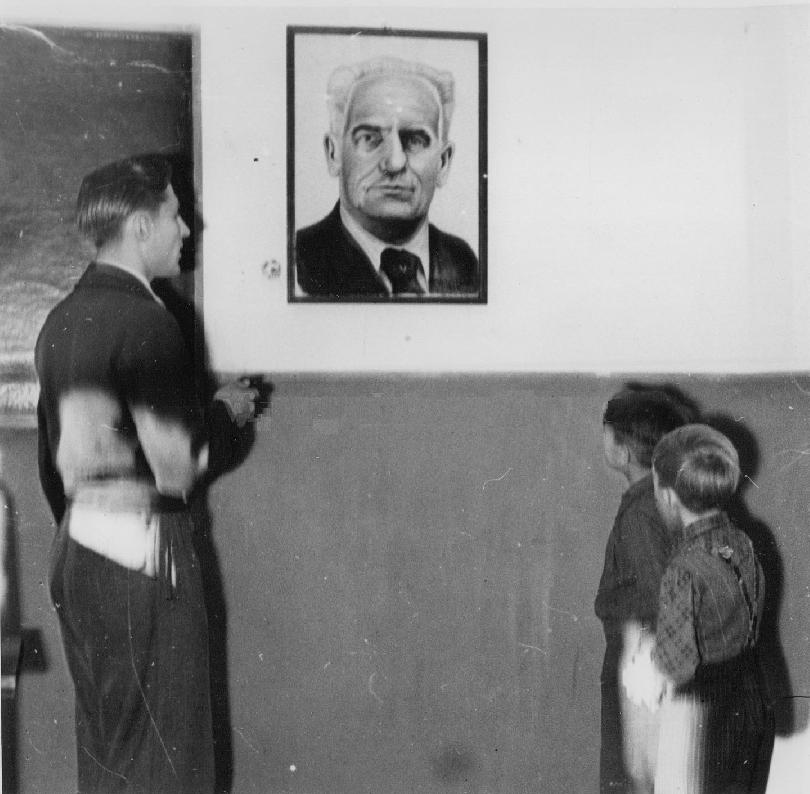
East German (DDR) Schools: Politicization

Figure 1.--Here we see a primary school teacher putting up a portrait of President Wilhelm Pieck in his clssroom during 1949. Pieck was a German Communist who spent much of the NAZI era in the Soviet Union. Some of the foreign Communists who sought refuge in the Soviet Union disappeared into the Gulag. Pieck was, however, a Stalin facorite. After the War, Stalin gave him the task of uniting the pre-NAZI Communist (KPD) and Socialist (SPD) parties. The result was the ruling DDR party--the Sococilist Unity Party (SED). This of course meant turning socialists into Communirs and purging the unconverted. The press caption read, Stead of Hitler: Pitures of Wilhelm Pieck, President of Communist-Dominated Germany, are taking the place of Hitler portraitsin East-German schools, in compliance with an official order. The province of Mecklenburg was the first to report that there is no class room wihout a portrait of the 'father of the German republic'. Hre, a Pieck portrait has a prominent place at the blackboard in a Mecklenburg school." The photograph was dated November 15, 1949.
|
|
We also suspect that the schools were highly politicized (Which was also the case in NAZI schools). Politiczation began very early for children in East Germany. And there no effort at digusing it. An example of an approved kids songs was "I want to be a Volkspolizist." Nursery schools-age kids had to draw pictures of the Grenzsoldaten (the border guards with shoot-to-kill orders). The DDR day-care centers were rigid, authoritarian, and uninspired. A central focus was to promote 'group-think'. Creativity was not high on the educational priorities. Punishments could be severe, too: standing in the corner, no lunch, sometimes even spankings. [Hockenos] DDR teachers not only politicized the classroon., but they politicized cultural mattrs like jens and rock and roll music. Students were expelled from secondary schools for wearing jeans. Jeans were seen as political expression, suggesting a favoravle attitude toward American and Western culture. [Poiger] And of course portraits of the DDR leaders appeared in DDR classrooms. In Democratic countries we often have portaits of historical leaders like Washington and Lincoln. In the DDR and other Communist countries you have images of the current very political figures. There were no free classroom discussions about major issues. Teachers lectured the childern are comducted carefully guided discussions. Here we would be very interested in finding German readers who could tell us about their teachers and the discussions they recall in their DDR classrooms. The DDR had a special problem with politization. DDR ctizens could listen to BRD television and radio broadcasts. So they had access to free speech and discussion on major issues and perhaps even more important commercials advertising the consumer products available to people in free society. Younger children in the DDR might not understand the Cold War issues, but they could understand all tghe great producrs available in the west and were not available to them. The DDR classroom politicization does not seem to have been very effective given the widespread support for unification after the Wall came down an young people were especially desirous of joining the West. One aspect of DDR polititization that was effective was the athesist campaign. The DDR effectively eradicated religion Church attendance in the East today is at very low levels. [Kim] Politicazation through education did not end with the schools. One young East German only a few years out of university reports how she got into trouble with the police after she refused to report on some journalist friends. The day before she was supposed to report for 'political education' she crossed over the border to West Berlin which before the Wall was built was still porous. [F.] We believe that some teacher reported to the Stazi. Comments of younger students who were oblivious to the children might reflect on the parents. Older students might be aware of the comsequences and thus kept quiet. If not it cwouls affect their chances for university plcement anf job opportunities. Here older students would report on each other.
Sources
Connelly, John. "Humboldt im Staatsdienst: Ostdeutsche Universitäten 1945-1989," in Mitchell G. Ash, ed.,
Mythos Humboldt: Vergangenheit und Zukunft der deutschen Universitäten (Vienna, 1999), pp. 58-104.
F., Ursula. Interviewed by Jennie Rothenberg Gritz, "What was it really like to escape East Germany?" The Atlantic. Website post (October 3, 2015).
Hockenos, Paul. "8 Things That Were Better in East Germany: Remembering the "glory days" of nudity, breast milk, and recycling 25 years after the fall of the Berlin Wall," FP (November 7, 2014).
Kim, Lucian. "Why East German teens seek secular rite of passage," Christian Sciene Monitor (May 12, 1999).
Lof, Sylvia, Ingrid Mållberg and Dietrich Rosenthal. One Europe: East Germany (Longman).
Poiger, Uta G. Jazz, Rock, and Rebels: Cold War Politics and American Culture in a Divided Germany (University of California Press: 2000), 333p.
HBC-SU

Related Chronolgy Pages in the Boys' Historical Web Site
[Main Chronology Page]
[The 1880s]
[The 1930s]
[The 1940s]
[The 1950s]
[The 1960s]
[The 1970s]
[The 1980s]
Related Style Pages in the Boys' Historical Web Site
[Main school uniform page]
[Main German school page]
[Long pants suits]
[Short pants suits]
[Socks]
[Eton suits]
[Jacket and trousers]
[Blazer
[School sandals]
Navigate the HBC Country School Pages
[Return to the Main East German school page]
[Return to the Main German Cold War era school page]
[Return to the Main school uniform page]
[Return to the Main East German Cold War page]
[Australia]
[England]
[France]
[Germany]
[Italy]
[Japan]
[New Zealand]
[Scotland]
[United States]
Navigate the HBC School Section Page
[About Us]
[Activities]
[Chronology]
[Clothing styles]
[Countries]
[Debate]
[Economics]
[Garment]
[Gender]
[Hair]
[History]
[Home trends]
[Literary characters]
[School types]
[Significance]
[Transport and travel
[Uniform regulations]
[Year level]
[Other topics]
[Images]
[Links]
[Registration]
[Tools]
[Return to the Historic Boys' School Home]
Created: 5:20 AM 10/27/2017
Last updated: 5:20 AM 10/27/2017




